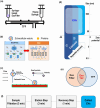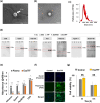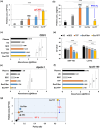Advanced Extracellular Vesicle Isolation: A Hybrid Electrokinetic-Tangential Flow Filtration Approach for Improved Yield, Purity, and Scalability
- PMID: 40736764
- PMCID: PMC12355454
- DOI: 10.1021/acs.analchem.5c01168
Advanced Extracellular Vesicle Isolation: A Hybrid Electrokinetic-Tangential Flow Filtration Approach for Improved Yield, Purity, and Scalability
Abstract
As extracellular vesicles (EVs) become increasingly important in diagnostics and therapeutics, achieving both improved purity and yield during isolation remains a critical challenge. Conventional techniques often suffer from the coisolation of nonvesicular particles and soluble proteins, limiting their clinical and research utility. In response, we introduce ExoTFF, a hybrid isolation technology that sequentially integrates electrokinetic filtration (ExoFilter) with size-exclusion tangential flow filtration (TFF) to deliver unprecedented performance gains through an iterative, synergistic mechanism. In the ExoTFF system, the sample is repeatedly circulated through an electrokinetic mesh filter and TFF until the liquid is removed. This recirculating flow gradually eliminates contaminants, while the electrokinetic filter continuously captures EVs as the sample is purified. Finally, any residual impurities in the TFF unit are completely removed via a dead volume elimination process. The complementary actions of these two distinct separation mechanisms double EV recovery rates and reduce impurity levels by 80% compared to conventional TFF, culminating in an impressive 800% improvement in the purity ratio. In proof-of-concept experiments, ExoTFF processed 10 mL of plasma within 10 min, efficiently depleting albumin and high-density lipoprotein (HDL) while achieving superior EV recovery. To further explore scalability, an automated ExoTFF system processed 500 mL of sample in 50 min, maintaining consistent yield and purity. The ability to sustain performance across different scales highlights ExoTFF's potential for both laboratory research and industrial-level EV production. Beyond biological applications, this platform also offers broad applicability for the isolation of negatively charged nanoparticles, demonstrating its potential impact across multiple nanotechnology-driven fields.
Figures




Similar articles
-
Prescription of Controlled Substances: Benefits and Risks.2025 Jul 6. In: StatPearls [Internet]. Treasure Island (FL): StatPearls Publishing; 2025 Jan–. 2025 Jul 6. In: StatPearls [Internet]. Treasure Island (FL): StatPearls Publishing; 2025 Jan–. PMID: 30726003 Free Books & Documents.
-
Optimized Tangential Flow Filtration for Efficient Isolation of Highly Pure and Bioactive sEVs.Anal Chem. 2025 Aug 12;97(31):17261-17274. doi: 10.1021/acs.analchem.5c03781. Epub 2025 Jul 31. Anal Chem. 2025. PMID: 40746027
-
Isolation of therapeutic extracellular vesicles using nanoporous membranes with uniform nanopores.Biomed Microdevices. 2025 Jul 10;27(3):35. doi: 10.1007/s10544-025-00761-2. Biomed Microdevices. 2025. PMID: 40637893
-
Management of urinary stones by experts in stone disease (ESD 2025).Arch Ital Urol Androl. 2025 Jun 30;97(2):14085. doi: 10.4081/aiua.2025.14085. Epub 2025 Jun 30. Arch Ital Urol Androl. 2025. PMID: 40583613 Review.
-
High-throughput capture and in situ protein analysis of extracellular vesicles by chemical probe-based array.Nat Protoc. 2025 Apr;20(4):1057-1081. doi: 10.1038/s41596-024-01082-z. Epub 2024 Oct 22. Nat Protoc. 2025. PMID: 39438698 Review.
References
MeSH terms
LinkOut - more resources
Full Text Sources
Research Materials

